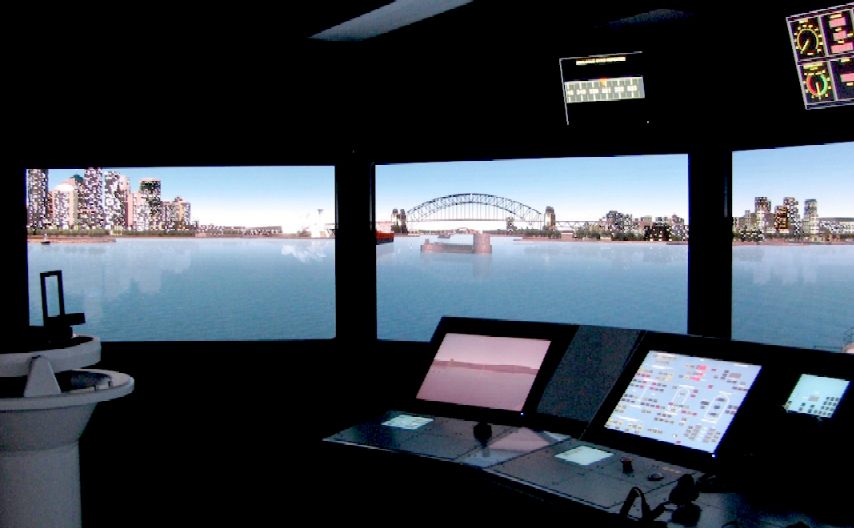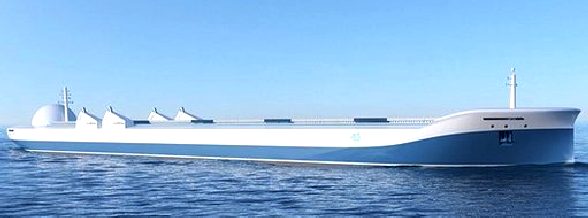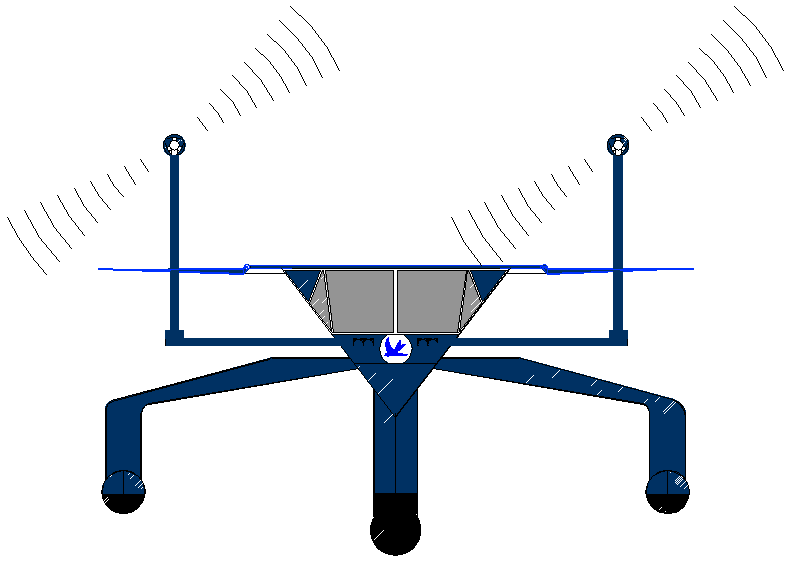|

DNV
GL's proposal for more efficient transport is via a battery powered
vessel similar to the above. UAVs
have been approved by the FAA for civilian operations, crop dusting,
border controls and film making. GOOGLE - Are streets ahead with
autonomous cars that have a 100% safety track record at time of
publication. So why should shipping be any different?
REVOLT
- DNV GL SEPTEMBER 11, 2014
Classification society DNV GL thinks that an unmanned, battery powered vessel could revolutionize short sea shipping.
DNV GL says that short sea shipping is a promising alternative to overstretched land based logistic networks. In response, DNV GL researchers at classification society DNV GL have developed ReVolt, a vessel touted as greener, smarter and safer than conventionally
fueled and operated vessels.
Described as "autonomous, fully battery powered and highly efficient," ReVolt is powered by a 3,000 kWh battery. This reduces operating costs by minimizing the number of high maintenance parts such as rotational components. The vessel has a range of 100 nautical miles, before the battery needs to be charged. If the energy required for that is harnessed from renewable sources, this would eliminate carbon dioxide emissions.
ReVolt does not require a crew and therefore, says DNV GL, goes a long way in tackling one of the shipping industries' weakest links: the safety record.
"With an average of 900 fatalities per year the mortality rate in shipping is 90 percent higher than in comparable land-based industries," DNV GL says. "Studies have shown that the majority of these accidents are caused by human error. Unmanned vessels take this factor out of the equation and make the operation of these ships more cost-efficient."
The vessel has an average speed of 6 knots and faces less water resistance than other ships, which usually travel at about 8.7 knots. The slight loss of speed allowed the engineers to fit a straight vertical bow, further reducing water resistance along the ship's entire profile and ultimately saving energy.
With no crew, there is no need for crew facilities such as the superstructure on board this vessel. The resulting increase in loading capacity, as well as low operating and maintenance costs, mean that compared to a diesel-fueled ship ReVolt could save up to $34 million over its estimated 30-year life.
The concept-ship is currently still being tested.
"Building and operating this vessel would be possible with today's technology. ReVolt is intended to serve as inspiration for equipment makers, ship yards and ship owners to develop new solutions on the path to a safe and sustainable future," says Hans Anton Tvete,
a senior researcher at DNV GL.

DNV
GL's 'ReVolt' ship showing uncluttered decks and no helm - a bonus in
reducing wind resistance, hence drag. Thus lowering the overall energy
required for transit.
ABOUT
DNV GL
As of 12 September 2013, DNV and GL
merged to form DNV GL. They are one of the world’s leading ship and offshore classification
societies (in the top 3 certification bodies), and a leading technical advisor to the global oil and gas
industry. From the above article it is apparent that DNV GL are active in
the field renewables and energy efficiency.
DNV
GL also provide software and independent expert advisory services to the maritime, oil and gas, and energy industries.
They operate in more than 100 countries, with 16,000 professionals dedicated to helping
their customers make the world safer, smarter and greener.

This
is a rendition of a virtual helm, as per the by Rolls Royce development
program, in part sponsored by the TSB.
UNMANNED
SHIPS, FEBRUARY 2014
Rolls-Royce has been working on hardware and software systems designed to turn the giant cargo ships that are responsible for 90 percent of intercontinental world trade into semi or fully autonomous robots. The company says that these drone ships would be safer and more efficient than manned ships, but the shipping industry isn't buying it.
Rolls-Royce’s Blue Ocean development team, which is leading the project, says that taking humans off of ships (and removing all of the human-related infrastructure, like crew quarters, heating and air conditioning, water purification and storage, etc.) would lead to ships that weigh 5 percent less and would use up to 15 percent less fuel. Additionally, the average cargo ship costs between US $3,000 and $4,000 per day in crew operating expenses alone.
To keep humans in the loop somewhere, Rolls-Royce is also creating on a prototype virtual reality display system that gives a captain (or whatever you call someone in charge of a ship when they're not actually on said ship) 360-degree views from a virtual bridge. The captain can hop from virtual bridge to virtual bridge, theoretically overseeing many different ships all at once through remote supervised autonomy.
While unmanned cargo ships are currently illegal, Rolls-Royce is optimistic that "the
technology is at the level where we can make this happen, and society is moving in this direction."
Unfortunately, making this happen is not going to be easy. It's not because the technology isn't there, but rather because humans have been in control of ships for so long that there's a lot of resistance to changing that, mostly surrounding what seems to be an implicit belief that it's just not something that's realistically possible to execute safely.
Unmanned ships should be considered in the same terms as we consider unmanned cars and other unmanned systems. This is a big "should," because it's not the way it works in practice, but still: what we should be asking is not how safe we can make an unmanned ship, but whether we can make an unmanned ship as safe or safer than a manned one. If we can cross that threshold, then we should be willing to go the unmanned route, especially if there are significant additional benefits. And considering that (as with just about everything) human error causes most maritime accidents, there's potential to make sea travel much safer than it is today.
Humans, strictly speaking, are absolutely awful at things like driving cars and steering ships for long periods of time, because it's boring, we're lazy, and sooner or later we get tired and stop paying attention. We just have to get over the knee-jerk reaction that humans can do a better job at it than an
autonomous system. As one maritime standards association member put it, "Can you imagine what it would be like with an unmanned vessel with cargo on board trading on the open seas? You get in enough trouble with crew on board."
Er, yeah, that's kind of the point, isn't it? Humans cause trouble. Computers don't. Or at least, when they cause trouble, they do so in ways that are often predictable, and if they do manage to screw up, other
computers can stop them before anything really bad happens. If all else fails, and something really bad does happen, you can go back and figure out exactly why it happened and prevent it from happening again. That's one of the advantages of technology, but not everyone agrees:
“It cannot and will never replace the eyes, ears, and thought processes of professional seafarers,” Dave Heindel, chairman of the ITF’s seafarers’ section in
London, said in [a statement emailed to
Bloomberg]. “The human element is one of the first lines of defense in the event of machinery failure and the kind of unexpected and sudden changes of conditions in which the world’s seas specialize. The dangers posed to the environment by
unmanned vessels are too easily imagined.”
Now, I'm not a sailor, and people who know more about this sort of thing than I do should feel free to correct me on this, but I have to imagine that the world's seas offer conditions that are no more complex, and potentially far less complex, than the conditions that you'd find driving around downtown San Francisco during rush hour. Furthermore, we already know that sensors (like
radar) are better than humans at detecting other ships and obstacles in the water, especially in the dark or in bad weather.
There's an obvious path forward from here: do what Google did with its autonomous car program. Make the ships autonomous, but keep a human behind the wheel until we've built up some confidence in the technology. Perhaps we gradually decrease the dependence on crew, and increase opportunities for teleoperation. And maybe it'll never make sense to completely remove
humans from ship operations, but significantly reducing the crew to improve both safety and efficiency at the same time certainly sounds like a good idea to me.
ACADEMIA
Currently the debate is more academic than operational, said Peter Sand, an analyst at the Bagsvaerd, Denmark-based Baltic and International Maritime Council, whose members control about 65 percent of the global fleet. None of them have raised the question of drone ships with the trade group, he said.
Levander of Rolls Royce is accustomed to chilly receptions. When he broached the subject at an industry conference in
London last May, the audience audibly scoffed, and other speakers on Levander’s panel dismissed the idea.
“If everybody in the industry would say, ‘Yes, this is the way to go,’ then we are too late,” Levander said. “I expect ship owners to be conservative, but it will change.”
The Bloomberg reporter and editor on this story are: Isaac Arnsdorf in New York
iarnsdorf@bloomberg.net and Millie Munshi at
mmunshi@bloomberg.net

DNV
GL CONTACTS
DNV
GL headquarters
Veritasveien 1
Høvik
Norway
P.O.Box 300
1322 Høvik
Norway
Phone: +47 6757 9900
ReVolt
Project
Per Wiggo
Richardsen
Media
Director
DNV GL - Maritime
Email: per.wiggo.richardsen@dnvgl.com
Phone: +47 907 77 829





LINKS
& REFERENCE
DNVGL
news Revolt
http://www.dnvgl.com/news-events/news/revolt.aspx
Rolls-Royce
predicts drone ships in a decade
http://www.slashgear.com/rolls-royce-predicts-drone-ships-in-a-decade-27310153/
BBC
technology news
http://www.bbc.co.uk/news/technology-26438661
Planning-for-a-future-of-robot-ships
http://www.safety4sea.com/planning-for-a-future-of-robot-ships-19611
Driverless-cars-meet-captainless-ships-autonomous-vehicles-to-take-to-the-sea/
http://www.bbc.co.uk/news/technology-26438661
http://singularityhub.com/2014/03/18/driverless-cars-meet-captainless-ships-autonomous-vehicles-to-take-to-the-sea/
Autonomous-cargo-vessels-could-set-sail-without-crew-under-watchful-eye
Unmanned
autonomous ships
http://www.unmanned-ship.org/munin/about/the-autonomus-ship/
Unmanned-cargo-ships-face-industry-resistance-are-a-good-idea-anyway
Rolls
Royce Waterspeed
http://www.rolls-royce.com/marine/ship_design_systems/
http://oceanleadership.org/unmanned-vessels-future-ocean/

An
example of an ocean going drone vessel, that may be used in much the
same manner as aerial drones, for persistent surveillance, but also as
important countermeasures to UAVs or other remotely piloted vehicles, in
taking them down in times of hostility, or where invading sovereign territory.
See GB2511731, published on the 17th September 2014. The concept has far
wider ramifications, such as the harvesting of wind and solar energy for
truly energy self-sufficient cruising.
|





